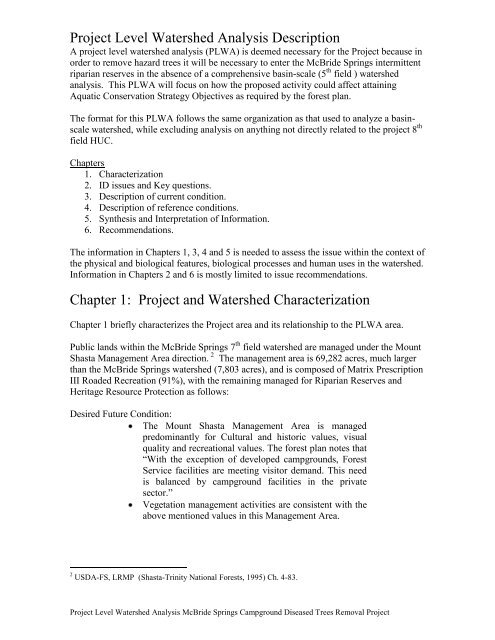Project Level Watershed Analysis McBride Springs Campground ...
Project Level Watershed Analysis McBride Springs Campground ...
Project Level Watershed Analysis McBride Springs Campground ...
You also want an ePaper? Increase the reach of your titles
YUMPU automatically turns print PDFs into web optimized ePapers that Google loves.
<strong>Project</strong> <strong>Level</strong> <strong>Watershed</strong> <strong>Analysis</strong> Description<br />
A project level watershed analysis (PLWA) is deemed necessary for the <strong>Project</strong> because in<br />
order to remove hazard trees it will be necessary to enter the <strong>McBride</strong> <strong>Springs</strong> intermittent<br />
riparian reserves in the absence of a comprehensive basin-scale (5 th field ) watershed<br />
analysis. This PLWA will focus on how the proposed activity could affect attaining<br />
Aquatic Conservation Strategy Objectives as required by the forest plan.<br />
The format for this PLWA follows the same organization as that used to analyze a basinscale<br />
watershed, while excluding analysis on anything not directly related to the project 8 th<br />
field HUC.<br />
Chapters<br />
1. Characterization<br />
2. ID issues and Key questions.<br />
3. Description of current condition.<br />
4. Description of reference conditions.<br />
5. Synthesis and Interpretation of Information.<br />
6. Recommendations.<br />
The information in Chapters 1, 3, 4 and 5 is needed to assess the issue within the context of<br />
the physical and biological features, biological processes and human uses in the watershed.<br />
Information in Chapters 2 and 6 is mostly limited to issue recommendations.<br />
Chapter 1: <strong>Project</strong> and <strong>Watershed</strong> Characterization<br />
Chapter 1 briefly characterizes the <strong>Project</strong> area and its relationship to the PLWA area.<br />
Public lands within the <strong>McBride</strong> <strong>Springs</strong> 7 th field watershed are managed under the Mount<br />
Shasta Management Area direction. 2 The management area is 69,282 acres, much larger<br />
than the <strong>McBride</strong> <strong>Springs</strong> watershed (7,803 acres), and is composed of Matrix Prescription<br />
III Roaded Recreation (91%), with the remaining managed for Riparian Reserves and<br />
Heritage Resource Protection as follows:<br />
Desired Future Condition:<br />
The Mount Shasta Management Area is managed<br />
predominantly for Cultural and historic values, visual<br />
quality and recreational values. The forest plan notes that<br />
“With the exception of developed campgrounds, Forest<br />
Service facilities are meeting visitor demand. This need<br />
is balanced by campground facilities in the private<br />
sector.”<br />
Vegetation management activities are consistent with the<br />
above mentioned values in this Management Area.<br />
2 USDA-FS, LRMP (Shasta-Trinity National Forests, 1995) Ch. 4-83.<br />
<strong>Project</strong> <strong>Level</strong> <strong>Watershed</strong> <strong>Analysis</strong> <strong>McBride</strong> <strong>Springs</strong> <strong>Campground</strong> Diseased Trees Removal <strong>Project</strong>
















